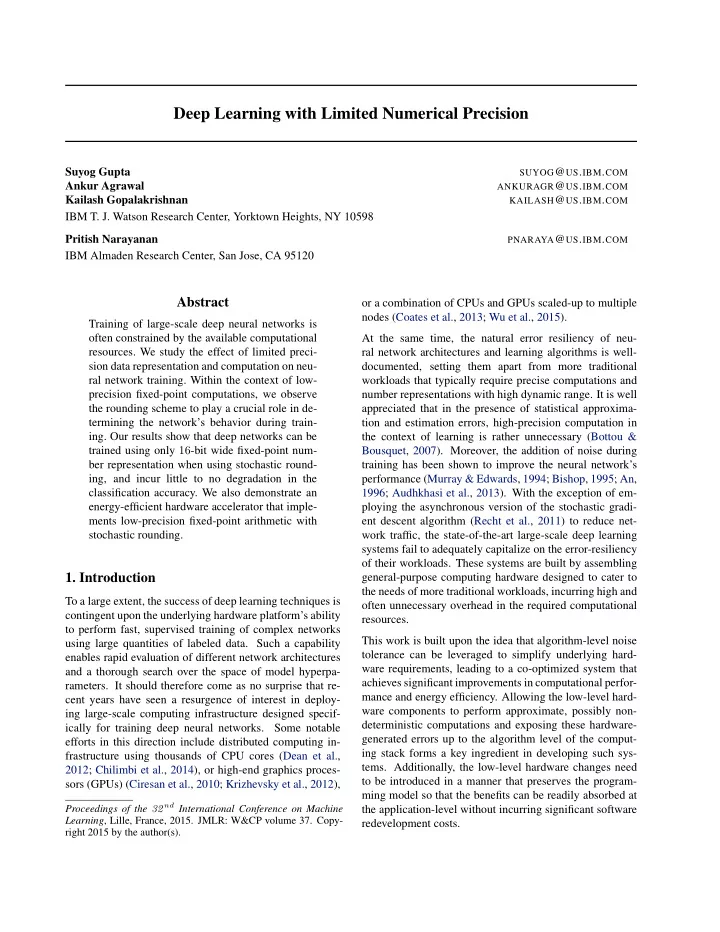

Deep Learning with Limited Numerical Precision Suyog Gupta SUYOG @ US . IBM . COM Ankur Agrawal ANKURAGR @ US . IBM . COM Kailash Gopalakrishnan KAILASH @ US . IBM . COM IBM T. J. Watson Research Center, Yorktown Heights, NY 10598 Pritish Narayanan PNARAYA @ US . IBM . COM IBM Almaden Research Center, San Jose, CA 95120 Abstract or a combination of CPUs and GPUs scaled-up to multiple nodes (Coates et al., 2013; Wu et al., 2015). Training of large-scale deep neural networks is often constrained by the available computational At the same time, the natural error resiliency of neu- resources. We study the effect of limited preci- ral network architectures and learning algorithms is well- sion data representation and computation on neu- documented, setting them apart from more traditional ral network training. Within the context of low- workloads that typically require precise computations and precision fixed-point computations, we observe number representations with high dynamic range. It is well the rounding scheme to play a crucial role in de- appreciated that in the presence of statistical approxima- termining the network’s behavior during train- tion and estimation errors, high-precision computation in ing. Our results show that deep networks can be the context of learning is rather unnecessary (Bottou & trained using only 16 -bit wide fixed-point num- Bousquet, 2007). Moreover, the addition of noise during ber representation when using stochastic round- training has been shown to improve the neural network’s ing, and incur little to no degradation in the performance (Murray & Edwards, 1994; Bishop, 1995; An, classification accuracy. We also demonstrate an 1996; Audhkhasi et al., 2013). With the exception of em- energy-efficient hardware accelerator that imple- ploying the asynchronous version of the stochastic gradi- ments low-precision fixed-point arithmetic with ent descent algorithm (Recht et al., 2011) to reduce net- stochastic rounding. work traffic, the state-of-the-art large-scale deep learning systems fail to adequately capitalize on the error-resiliency of their workloads. These systems are built by assembling 1. Introduction general-purpose computing hardware designed to cater to the needs of more traditional workloads, incurring high and To a large extent, the success of deep learning techniques is often unnecessary overhead in the required computational contingent upon the underlying hardware platform’s ability resources. to perform fast, supervised training of complex networks This work is built upon the idea that algorithm-level noise using large quantities of labeled data. Such a capability tolerance can be leveraged to simplify underlying hard- enables rapid evaluation of different network architectures ware requirements, leading to a co-optimized system that and a thorough search over the space of model hyperpa- achieves significant improvements in computational perfor- rameters. It should therefore come as no surprise that re- mance and energy efficiency. Allowing the low-level hard- cent years have seen a resurgence of interest in deploy- ware components to perform approximate, possibly non- ing large-scale computing infrastructure designed specif- deterministic computations and exposing these hardware- ically for training deep neural networks. Some notable generated errors up to the algorithm level of the comput- efforts in this direction include distributed computing in- ing stack forms a key ingredient in developing such sys- frastructure using thousands of CPU cores (Dean et al., tems. Additionally, the low-level hardware changes need 2012; Chilimbi et al., 2014), or high-end graphics proces- to be introduced in a manner that preserves the program- sors (GPUs) (Ciresan et al., 2010; Krizhevsky et al., 2012), ming model so that the benefits can be readily absorbed at Proceedings of the 32 nd International Conference on Machine the application-level without incurring significant software Learning , Lille, France, 2015. JMLR: W&CP volume 37. Copy- redevelopment costs. right 2015 by the author(s).
Recommend
More recommend